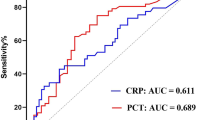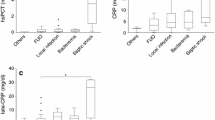Abstract
The aim of this study was to evaluate the accuracy of procalcitonin (PCT) in predicting infective endocarditis (IE). 23 adult patients with IE, 30 patients with sepsis and 30 with tick-borne encephalitis were included in this prospective study. The PCT serum level, C-reactive protein (CRP), total leukocyte, and immature polymorphonuclear (PMN) cell counts were determined on admission, prior to the institution of antibiotic therapy, and compared according to the diagnosis. The median PCT level in patients with IE endocarditis was 0.81 ng/ml, in patients with sepsis it was 43.74 ng/ml, and in the group with viral infection it was 0.25 ng/ml (P < 0.001). The highest PCT level was found in patients with Staphylococcus aureus endocarditis. The area under the receiver operating characteristic curve that used PCT to predict IE was 0.722 (95% CI 0.572–0.873), compared with 0.909 (95% CI 0.829–0.989) for CRP, 0.699 (95% CI 0.551–0.846) for immature PMN cell count, and 0.619 (95% CI 0.468–0.770) for leukocyte count. Our study fails to demonstrate superiority of PCT as a diagnostic laboratorial parameter in predicting IE compared to CRP.

Similar content being viewed by others
References
Mylonakis E, Calderwood SB (2001) Infective endocarditis in adults. N Engl J Med 345:1318–1330
Hoen B, Alla F, Selton-Suty C et al (2002) Changing profile of infective endocarditis: results of a 1-year survey in France. JAMA 288:75–81
Berlin JA, Abrutyn E, Strom BL et al (1995) Incidence of infective endocarditis in the Delaware Valley, 1988–1990. Am J Cardiol 76:933–936
Hogevik H, Olaison L, Andersson R, Linberg J, Alestig K (1995) Epidemiologic aspects of infective endocarditis in an urban population: a 5-year prospective study. Medicine (Baltimore) 74:324–339
Lejko-Zupanc T, Koželj M, Pikelj F (1994) Novejši pogledi na patogenezo, epidemiologijo, klinično sliko in diagnostiko infekcijskega endokarditisa. Med Razgl 33:501–508
Durack DT, Lukes AS, Bright DK (1994) Duke Endocarditis Service. New criteria for diagnosis of infective endocarditis: utilization of specific echocardiographic findings. Am J Med 96:200–208
Li JS, Sexton DJ, Mick N et al (2000) Proposed modifications to the Duke criteria for the diagnosis of infective endocarditis. Clin Infect Dis 30:633–638
de Werra I, Jaccard C, Corradin SB et al (1997) Cytokines, nitrite/nitrate, soluble tumor necrosis factor receptors, and procalcitonin concentrations: comparisons in patients with septic shock, cardiogenic shock, and bacterial pneumonia. Crit Care Med 25:607–613
Brunkhorst FM, Wegscheider K, Forycki ZF, Brunkhorst R (2000) Procalcitonin for early diagnosis and differentiation of SIRS, sepsis, severe sepsis, and septic shock. Intensive Care Med 26:S148–S152
Kocazeybek B, Kucukoglu S, Oner YA (2003) Procalcitonin and C-reactive protein in infective endocarditis: correlation with etiology and prognosis. Chemotherapy 49:76–84
Mueller C, Huber P, Laifer G, Mueller B, Perruchoud AP (2004) Procalcitonin and the early diagnosis of infective endocarditis. Circulation 109:1707–1710
Watkin RW, Harper LV, Vernallis AB et al (2007) Pro-inflamatory cytokines IL-6, TNF-α, IL 1β, procalcitonin, lipopolysaccharide binding protein and C-reactive protein in infective endocarditis. J Infect 55:220–225
Cuculi F, Toggweiler S, Auer M, Auf der Maur C, Zuber M, Erne P (2008) Serum procalcitonin has the potential to identify Staphylococcus aureus endocarditis. Eur J Clin Microbiol Infect Dis 27:1145–1149
ACC/AHA (2006) Guidelines for the management of patients with valvular heart disease. Circulation 114:e84–e231
Bone RC, Balk RA, Cerra FB et al (1992) American College of Chest Physicians/Society of Critical Care Medicine Consensus Conference: definitions for sepsis and organ failure and guidelines for the use of innovative therapies in sepsis. Chest 101:1644–1655
Hofmann H, Heinz FX, Dippe H (1983) ELISA for IgM and IgG antibodies against tick-borne encephalitis virus: quantification and standardization of results. Zbl Bakt Hyg 255:448–455
Meisner M (2000) Procalcitonin (PCT). A new, innovative infection parameter. Biochemical and clinical aspect. Georg Thieme Verlag, Stuttgart
Shively BK, Gurule FT, Roldan CA, Leggett JH, Schiller NB (1991) Diagnostic value of transesophageal compared with transthoracic echocardiography in infective endocarditis. J Am Coll Cardiol 18:391–397
Dodds GA, Sexton DJ, Durack DT, Bashore TM, Corey GR, Kisslo J (1996) Negative predictive value of the Duke criteria for infective endocarditis. Am J Cardiol 77:403–407
Al-Nawas B, Krammer I, Shah PM (1996) Procalcitonin in diagnosis of severe infections. Eur J Med Res 1:331–333
Jereb M, Muzlovič I, Hojker S, Strle F (2001) Predictive value of serum and cerebrospinal fluid procalcitonin levels for the diagnosis of bacterial meningitis. Infection 29:209–212
Assicot M, Gendrel D, Carsin H, Rajmond J, Guilbaud J, Bohuon C (1993) High serum procalcitonin concentrations in patients with sepsis and infection. Lancet 341:515–518
Jereb M, Kotar T (2006) Usefulness of procalcitonin to differentiate typical from atypical community-acquired pneumonia. Wien Klin Wochenschr 118:170–174
Dandona P, Nix D, Wilson MF et al (1994) Procalcitonin increase after endotoxin injection in normal subject. J Clin Endocrinol Metab 79:1605–1608
Al-Nawas B, Shah PM (1996) Procalcitonin in patients with and without immunosuppression and sepsis. Infection 24:434–436
Conflict of interest statement
The authors declare that they have no conflict of interest related to the publication of this manuscript.
Author information
Authors and Affiliations
Corresponding author
Rights and permissions
About this article
Cite this article
Jereb, M., Kotar, T., Jurca, T. et al. Usefulness of procalcitonin for diagnosis of infective endocarditis. Intern Emerg Med 4, 221–226 (2009). https://doi.org/10.1007/s11739-009-0245-4
Received:
Accepted:
Published:
Issue Date:
DOI: https://doi.org/10.1007/s11739-009-0245-4




